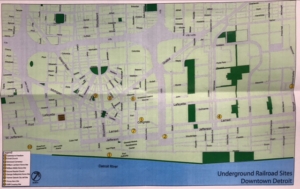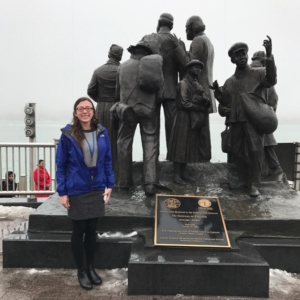On February 7th, I joined students from Wayne County Community College on an Underground Railroad Tour led by Kimberly Simmons. Simmons is the Executive Director & President of the Detroit River Project, author of A Fluid Frontier, and a Mayflower descendant with strong connections to the Underground Railroad as the great great great granddaughter of Caroline Quarlls Watkins (the first documented UGGR escapist through the state of Wisconsin). I found the tour incredibly interesting and wanted to share about it. If you get the chance to take her tour, definitely do!
Many people are familiar with the Underground Railroad and that it was a network of people working to help others to freedom. Detroit has a special place in the Underground Railroad – known as Midnight because it was the last stop before freedom in Canada, which was known as Dawn. Simmons and many others hope and are working for the Detroit River to become a World Heritage site through UNESCO.
During the years of the UGRR, only 100,000 escaped out of the nearly 5 million who were enslaved. 20,000 to 30,000 (over ¼) of these people crossed the Detroit River looking for freedom.
We went to over 10 stops from downtown to the Elmwood Cemetery including the Gateway to Freedom statue and Second Baptist Church. The Gateway to Freedom statue is not just in Detroit; there is a sister statue across the river in Windsor. The history of the Second Baptist Church was familiar to me since Challenge Detroit took a tour of the Historical Museum led by Jamon Jordan back in August!

Map of bus tour

Gateway to Freedom statue
This tour debunked the following myths of the UGRR.
- Harriet Tubman is a hero of the UGRR without a doubt but it is often said that she rescued thousands of people when it was about 70 and mostly her family. She was also never in Detroit.
- The white quilt with certain shapes was not the universal symbol for a place where people were safe because not everyone knew what this quilt meant and not everyone had them. Each safe place had some sort of indicator and the last person the freedom seekers stayed would hopefully know about the next stop and tell them how to recognize it.
- It was not necessarily a group effort like families going somewhere together as most of the 100,000 escapes were self-emancipation.
